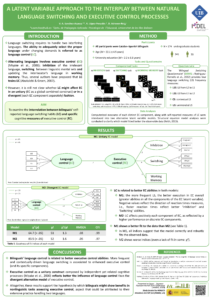Presented at Sepex–Sepneca–Aipexperimental Joint Conference (Madrid, 2018)
Authors Sanchez-Azanza, Victor A.; López-Penadés, Raúl; Adrover Roig, Daniel
Corresponding author v.sanchez@uib.es
Abstract
Language switching (LS) is a common behavior in bilinguals that requires the management of two competing languages by selecting one of them and inhibiting the other, a process involved in language control (LC). It has been proposed that LC involves and trains general executive control (EC) processes. In this vein, we explored the interplay between self-reported LS habits and several measures tapping on different subcomponents of EC through structural equation modelling (SEM) adopting a latent variable perspective. Results showed that, after controlling for the age of the second language’s onset, frequent self-reported LS was associated with better EC abilities. Moreover, a better fit was found when considering EC as a unitary mechanism as compared to a competing model with a direct relation between LS and several EC subcomponents. Specifically, the EC improvement was indexed by larger working memory span (updating), and both faster response times in a Flanker task (interference inhibition), and in the feature-switching task (task switching). These findings endorse the hypothesis that bilinguals show benefits in EC mechanisms under non-verbal conditions due to their experience in controlling two languages.

